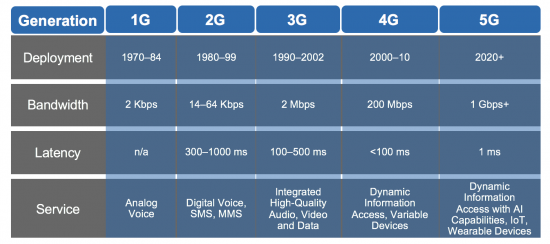The 2017 Cisco Mobile Visual Networking Index (VNI) forecasts that there will be about 25 million 5G capable devices and connections by 2021, which will generate 8.9 exabytes (EB) of annual mobile data traffic. Let’s compare that in context of the overall Mobile VNI Forecast. By 2021, there will be nearly 12 billion mobile devices and connections generating 587 EB of annual mobile traffic globally. As a percentage share then, 5G will account for less than half a percent of total mobile devices and connections and one and a half percent of total mobile traffic.
Figure 1. 5G Connections and Traffic by network

Source:Cisco VNI Global Mobile Data Traffic Forecast, 2016–2021
Those absolute and relative 5G projections might not seem impressive at first glance. However, if we look at the expected average monthly traffic per 5G connection in relation to the average 3G and 4G connections, the variance is significant (if not awe-inspiring).
Figure 2. Average monthly traffic per 3G, 4G and 5G connection

Note: One HD movie is estimated to be approximately 3GB
Source:Cisco VNI Global Mobile Data Traffic Forecast, 2016–2021
There is a lot of discussion and anticipation around the launch of 5G networks – it is expected to resolve many if not all of cellular connectivity problems. 5G is expected to address a variety of current mobility issues. The ITU Radiocommunication Sector (ITU-R) envisages 5G as an enhanced mobile broadband solution that will deliver ultra-reliable and low latency communications while dynamically supporting massive volumes machine type communications.
Figure 3. ITU-R 5G Usage Scenarios

Source: Rec. ITU-R M.2083-0
With a potential bandwidth capacity of 1 Gbps and ultra-low latency of 1 millisecond (ms) combined with software defined networking (SDN) and network functions virtualization (NFV), 5G promises to be a game-changing technology. It is expected to:
- Complement (and in some cases even supplement) broadband connectivity for optimum end user experiences
- Enhance and increase the usage of cloud applications and storage
- Promote tactile Internet – necessary for virtual reality and emerging applications such as autonomous cars and remote tele-surgery
- Support high and ultra-high definition video and rich media telecommunications
- Accommodate a wide range of machine-to-machine M2M communications
There are several issues that remain to be addressed before significant commercial 5G deployments commence (starting in 2020). Can you imagine the impact of 5G on today’s data cap structures? Currently, top 1 percent of mobile users consume 30 GB of monthly data. When 5G is introduced, 30GB will be the average. My fellow Cisco VNI senior analyst Usha Andra will cover the issue of 5G and data caps more fully in a future blog. And that is only one of the issues. Mobile carriers also need to figure out how to fairly and profitably monetize 5G services. In addition, there is the big question of spectrum availability and allocation. Currently there are several field trials and pre-commercial deployments underway globally (US, South Korea, Japan, Russia and China) in sub 6MHz and mm-wave bands to test out 5G performance. Perhaps 5G will require spectrum in both sub 6MHz as well as mm-wave bands to address the wide area, low power usage requirements of machine type communications on the one end that have low bandwidth requirements and high latency tolerance and tactile Internet, reliable broadband applications on the other end that needs much higher bandwidth and low to ultra-low latency.
Figure 4. 5G Latency in Perspective

Source: Cisco VNI Global Mobile Data Traffic Forecast, 2016–2021
The other challenges besides monetization and spectrum allocation surrounding 5G commercial deployments are device availability, air-interface ratification and test data development. There are concentrated efforts underway to resolve these challenges so that 5G can deliver on the promise of optimized network utilization, open access and tactile Internet, and provide an important option not only for broadband connectivity but also for core networks.
Figure 5. Generations of Mobile Technology – A Snapshot

Source: Cisco VNI Global Mobile Data Traffic Forecast, 2016–2021
To see all of our Mobile VNI Forecast resources and online tools, please visit our public web site.

CONNECT WITH US